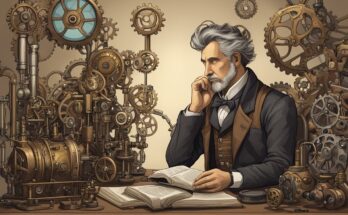Mr. Dumont at the helm of one of his aircraft
Alberto Santos Dumont
Born 1873, Died 1932
Age 33; 5 9″, 150 lbs; a young man with black hair and mustache and a slightly melancholy expression usually wearing elegant clothes.
Advantages: Reputation (“First man in the world to fly a powered heavier-than-air craft”), Very wealthy
Disadvantages: Pacifism (self-defense only), Obsession (Inventing better flying machines)
Quirks: Always wears his wristwatch when flying; Jules Verne fan; Melancholy; Uses dirigibles when visiting friends or going to the opera
Equipment: Flying machines aside, Santos Dumont owns what is probably the worlds first wristwatch
This represents Alberto Santos Dumont soon after he made the first official heavier-than-air powered flight in Europe. He is still regarded in Brazil as the “Father of Aviation.” (When faced with the argument that the Wright brothers made a heavier-than-air flight in 1903, Brazilians like to point out that the 14-bis, unlike the Wrights craft, was capable of taking off without external aid, and that ailerons were Santos Dumonts invention.
It is important to remember that the Wrights claim was widely disbelieved at the time, even in the United States. Hence, Dumonts reputation, while technically inaccurate, was widespread and not at all implausible).
Dumont was also known for demonstrating lighter-than-air craft that could be controlled and steered reliably, and for other inventions, including designs for hangars and sliding doors. He also worked on helicopter-like and float-equipped designs, without much success. The exact nature of his Pacisifm was rarely tested, but he clearly hated war; this feeling was the cause of his eventual sucide, so such a disadvantage is appropriate.
Circling the Eiffel Tower to win the Deutsch de la Murth prize
Biography
Alberto Santos Dumont was born in 1873, in the state of Minas Gerais in Brazil, but he grew up in the state of Sao Paulo, on a coffee plantation owned by his father, Henrique. At the age of 10, he had already read all of Jules Vernes books, and as a child, he had his parents permission to drive a locomotive loaded with coffee between the trees, as well as the plantations steam tractors.
In 1890, his father suffered an accident with rendered him partially paralyzed; in the following year, the family traveled to France where Henrique believed he could be cured, but he died in 1892. In Paris, Alberto completed his studies, and in 1898, ordered his first balloon, named “Brazil”, from a French firm where he worked as a volunteer pilot. In that same year, he constructed his first dirigible, which he called “Number 1”.
In 1901, he won the Deutsch de la Meurth prize for the first person to fly a dirigible from Saint Cloud Park to the Eiffel Tower and back in less than 30 minutes. While celebrating, Santos Dumont complained to Louis Cartier, a person friend, that during the flight he could barely check his performance on his pocket-watch, as this meant taking his hand off the controls. In response, Cartier designed a watch with a leather band and a buckle, intend to be worn above the left wrist. The wrist-watch had been invented.
Mr. Dumont preparing for flight (Center)
The next year, Dumont visited Edisons Laboratories in New York, was received by Theodore Roosevelt in the White House, and lost his mother, who died in Portugal.
In 1906, Dumont started work on a completely new idea, a powered biplane. To test it, he mounted it under his number 14 dirigible and freed it in flight. On October 23, the “14-bis” successfully took off before an astonished commission of judges from the Aero-Club de France, and landed safely after flying about 200 feet, winning a prize of 3.000 francs for the first pilot to fly at least 25 meters (82 feet) in a self-powered machine. In November, he flew 720 feet, winning another prize for the first person to fly more than 100 meters (328 feet).
Colorized picture of the 14-bis in flight
His next great success was his model 20, the “Demoiselle”, capable of flights longer than ten miles and speeds of 59 mph, and considered to be much more influential in aeronautics than the 14-bis. In 1910, however, he fell ill with what has since been diagnosed as multiple sclerosis, which reduced his capacity for active pursuits.
Dumont was a pacifist, and never accepted the use of aircraft in warfare. Extremely depressed by their use in World War 1, he returned to Brazil. In 1932, after the beginning of a local conflict in which aircraft were once more use as war machines, he committed suicide.
Post-flight photograph
Encountered
Before 1891, Dumont can be found living on his fathers plantations; anyone seeking him should not have a hard time, as his father is rich and well-known. After this date, he would most probably be found in Paris, but he sometimes traveled back to Brazil and to other countries. After the 14-bis flight, Dumont becomes famous around the world; locating him becomes trivial, thought catching him may be harder. Once anyone makes contact, remember that Dumont is an educated man from a rich family, and so is likely to be formal with strangers. His favorite topic of conversation will be aeronautics, but he will be very interested in general science and technology.
Closer image of the “Number 6” approaching the Eiffel Tower
Further Reading:
Santos Dumont, Alberto: My Airships: The Story of My Life
Winters, Nancy: Man Flies: The Story of Alberto Santos- Dumont, Master of the Balloon, Conqueror of the Air.
Wykeham, Peter: Santos-Dumont
Stoddard, W (1999) – Gurps Who’s Who I, pg. 114-115, SJG:Austin
[edited for removal of game specific content]
Online Resources:
http://en.wikipedia.org/wiki/Alberto_Santos-Dumont
http://www.centennialofflight.gov/essay/Dictionary/Santos-Dumont/DI41.htm
http://www.smithsonianeducation.org/scitech/impacto/graphic/aviation/alberto.html
http://www.first-to-fly.com/History/History%20of%20Airplane/santos_dumont.htm
http://www.aiaa.org/content.cfm?pageid=428



